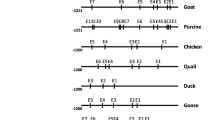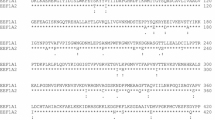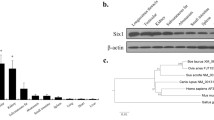Abstract
Myostatin (GDF8, MSTN) is a member of the transforming growth factor beta superfamily that is essential for proper regulation of skeletal muscle mass. In order to study its expression and regulatory mechanism deeply, we have presented a comparative analysis of about 170-kb pig BAC sequence containing the myostatin gene among pig, human and mouse. The genomic region is characterized by high interspersed repeats and low G+C content. As for the myostatin gene, a higher sequence similarity is found between human and pig than between these species and the mouse. One striking feature is that the structure of two TATA-boxes in the nearby downstream of CCAAT-box is identified in the promoter. Further analysis reveals that the TATA-box1 is responsible for the transcription in pig and human, but the TATA-box2 acts on the transcription in mouse. The other interesting feature is that two polyadenylation signal sequences (AATAAA) exist in 3’UTR of the pig myostatin gene. Moreover, a large number of potential transcription factor-binding sites are also identified in evolutionary conserved regions (ECRs), which may be associated with the regulation of myostatin. Many putative transcription factors play an important role in the muscle development, and the complex interaction between myostatin and these factors may be required for proper muscle development.
Similar content being viewed by others
References
McPherron, A. C., Lawler, A. M., Lee, S. J., Regulation of skeletal muscle mass in mice by new TGF-beta superfamily member, Nature, 1997, 387: 83–90.
Thomas, M., Langley, B., Berry, C. et al., Myostatin, a negative regulator of muscle growth, functions by inhibiting myoblast proliferation, J. Biol. Chem., 2000, 275(51): 40235–40243.
Yamanouchi, K., Soeta, C., Naito, N., Tojo, H., Expression of myostatin gene in regenerating skeletal muscle of the rat and its localization, Biochemical and Biophysical Research Communications, 2000, 270: 510–516.
Kambadur, R., Sharma, M., Smith, T. P. L., Bass, J. J., Mutations in myostatin (GDF-8) in double muscled Belgian Blue and Piedmontese cattle, Genome Res., 1997, 7: 910–916.
Zimmers, T. A., Davies, M. V., Koniaris, L. G. et al., Induction of cachexia in mice by systemically administered myostatin, Science, 2002, 296: 1486–1488.
Ji, S., Losinki, R. L., Cornelius, S. G. et al., Myostatin expression in porcine tissues: Tissue specificity and developmental and postnatal regulation, Am. J. Physiol., 1998, 275: R1265–1273.
Sonstegard, T. S., Rohrer, G. A., Smith, T. P. L., Myostatin maps to porcine chromosome 15 by linkage and physical analyses, Anim. Genet., 1998, 29(1): 19–22.
Strail, A., Kopecny, M., Genomic organization, sequence and polymorphism of the porcine myostatin (GDF8;MSTN) gene, Animal Genetics, 1999, 30(6): 468–470.
Jiang, Y. L., Li, N., Plastow, G. et al., Identification of three SNPs in the porcine myostatin gene (MSTN), Animal Biotechnology, 2002, 13: 173–178.
Sulston, J., Du, Z., Thomas, K. et al., TheC. elegans genome sequencing project a beginning, Nature, 1992, 365: 37–41.
Ansari-Lari, M. A., Oeltjen, J. C., Schwartz, S. et al., Comparative sequence analysis of a gene-rich cluster at human chromosome 6, Genome Res., 1998, 8: 29–40.
Kozak, M., An analysis of 5′-noncoding sequences from 699 vertebrate messenger RNAs, Nuc. Acids Res., 1987, 15: 8125–8148.
Kozak, M., An analysis of vertebrate mRNA sequence: Intimations of translational control, J. Cell Biol., 1991, 115: 887–903.
Mount, S. M., A catalogue of splice junction sequences, Nucleic Acids Res., 1982, 10: 459–472.
Pin, C. L., Konieczny, S. F., A fast fiber enhancer exists in the muscle regulatory factor 4 gene promoter, Biochem. Biophys. Res. Commun., 2002, 299: 7–13.
Langley, B., Thomas, M., Bishop, A. et al., Myostatin inhibits myoblast differentiation by down-regulating myoD expression, J. Biol. Chem., 2002, 277(51): 49831–49840.
Spiller, M. P., Kambadur, R., Jeanplong, F. et al., The myostatin gene is a downstream target gene of basic helix-loop-helix transcription factor MyoD, Mol. Cell Biol., 2002, 22(20): 7066–7082.
Denny, P., Swift, S., Connor, F., Ashworth, A., An SRY-related gene expressed during spermatogenesis in the mouse encodes a sequence-specific DNA-binding protein, EMBO J., 1992, 11: 3705–3712.
Ikeda, T., Zhang, J., Chano, T., Mabuchi, A., Fukuda, A., Identification and characterization of the human long form of Sox5 (L-SOX5) gene, Gene, 2002, 298: 59–68.
Marchat, L. A., Gomez, C., Perez, D. G. et al., Two CCAAT/enhancer binding protein sites are cis-activator elements of the Entamoeba histolytica EhPgp1 (mdr-like) gene expression, Cell Microbiol., 2002, 11: 725–737.
Pan, Z., Hetherington, C. J., Zhang, D. E., CCAAT/enhancer-binding protein activates the CD14 promoter and mediates transforming growth factor beta signaling in monocyte development, J. Biol. Chem., 1999, 274: 23242–23248.
Garcia-Trevijano, E. R., Iraburu, M. J., Fontana, L. et al., Two domains of MyoD mediate transcriptional activation of genes in repressive chromatin: a mechanism for lineage determination in myogenesis, Genes Dev., 1997, 11:436–450.
Andreucci, J. J., Grant, D., Cox, D. M. et al., Composition and function of AP-1 transcription complexes during muscle cell differentiation, J. Biol. Chem., 2002, 277(19): 16426–16432.
Morishita, R., Gibbons, G. H., Horiuchi, M., Kaneda, Y., Ogihara, T., Dzau, V. J., Role of AP-1 complex in angiotensin II-mediated transforming growth factor-beta expression and growth of smooth muscle cells: Using decoy approach against AP-1 binding site, Biochem. Biophys. Res. Commun., 1998, 243(2): 361–367.
Segil, N., Roberts, S. B., Heintz, N., Mitotic phosphorylation of the Oct-1 homeodomain and regulation of Oct-1 DNA binding activity, Science, 1991, 254(5039): 1814–1816.
Di Lisi, R., Millino, C., Calabria, E. et al., Combinatorial cis-acting elements control tissue-specific activation of the cardiac troponin I genein vitro andin vivo., J. Biol. Chem., 1998, 273: 25371–25380.
Lakich, M. M., Diagana, T. T., North, D. L., Whalen, R. G., MEF-2 and Oct-1 bind to two homologous promoter sequence elements and participate in the expression of a skeletal musclespecific gene, J. Biol. Chem., 1998, 273: 15217–15226.
Xiao, Q., Kenessey, A., Ojamaa, K., Role of USF1 phosphorylation on cardiac alpha-myosin heavy chain promoter activity, Am. J. Physiol. Heart Circ. Physiol., 2002, 283: H213–219.
Chen, Y. H., Layne, M. D., Watanabe, M., Yet, S. F., Perrella, M. A., Upstream stimulatory factors regulate aortic preferentially expressed gene-1 expression in vascular smooth muscle cells, J. Biol. Chem., 2001, 276: 47658–47663.
Lun, Y., Sawadogo, M., Perry, M., Autoactivation of Xenopus MyoD transcription and its inhibition by USF, Cell Growth Differ., 1997, 8: 275–282.
Thomas, P. S., Kasahara, H., Edmonson, A. M. et al., Elevated expression of Nkx-2.5 in developing myocardial conduction cells, Anat. Rec., 2001, 263(3): 307–313.
Nishida, W., Nakamura, M., Mori, S. et al., A triad of serum response factor and the GATA and NK families governs the transcription of smooth and cardiac muscle genes, J. Biol. Chem., 2002, 277(9): 7308–7317.
Kalenik, J. L., Chen, D., Bradley, M. E., Chen, S. J., Lee, T. C., Yeast two-hybrid cloning of a novel zinc finger protein that interacts with the multifunctional transcription factor YY1, Nucleic Acids Res., 1997, 25: 843–849.
Walowitz, J. L., Bradley, M. E., Chen, S., Lee, T., Proteolytic regulation of the zinc finger transcription factor YY1, a repressor of muscle-restricted gene expression, J. Biol. Chem., 1998, 273: 6656–6661.
Zheng, Z., Wang, Z. M., Delbono, O., Charge movement and transcription regulation of L-type calcium channel alpha(1S) in skeletal muscle cells, J. Physiol., 2002, 540: 397–409.
Onyango, P., Miller, W., Lehoezky, J. et al., Sequence and comparative analysis of the mouse 1-megabase region orthologoud to the human 11p5 imprinted domain, Genome Res., 2000, 10: 1697–1710.
Lander, E. S., Linton, L. M., Birren, B. et al., Initial sequencing and analysis of the human genome, Nature, 2001, 409: 860–892.
Waterston, R. H., Lindblad-Toh, K., Birney, E. et al., Initial sequencing and comparative analysis of the mouse genome, Nature, 2002, 420: 520–562.
Shibata, H., Yoda, Y., Kato, R. et al., A methylation imprint mark in the mouse imprinted gene Grf1/Cdc25Mm locus shares a common feature with U2afbp-rs gene: An association with a short tandem repeat and hypermethylated region, Genomics, 1998, 4930–4937.
Amarger, V., Nguyen, M., Laere, A. S. V. et al., Comparative sequence analysis of the INS-IGF2-H19 gene cluster in pigs, Mamm Genome, 2002, 13: 388–398.
Boyle, A. L., Ballard, S. G., Ward, D. C., Differential distribution of long and short interspersed element sequence in mouse genome: Chromosome karyotyping by fluorescencein situ hybridization, Proc. Natl. Acad. Sci., 1990, 87: 7757–7761.
Kundu, T. K., Rao, M. R., CpG islands in chromatin organization and gene expression, J. Biochem. (Tokyo), 1999, 125(2): 217–222.
Andersson, L., Archibald, A., Ashburner, M. et al., Comparative genome organization of vertebrates the first international workshop on comparative genome organization, Mamm. Genome, 1996, 7: 717–734.
Gispert, S., Dutra, A., Lieberman, A., Friedlich, D., Nussbaum, R. L., Cloning and genomic organization of the mouse gene Slc23a1 encoding a vitamin C transporter, DNA Research, 2000, 7: 339–345.
Zhang, L., Ge, L., Parimoo, S., Stenn, K., Prouty, S. M., Human stearoyl-CoA desaturase: Alternative transcripts generated from a single gene by usage of tandem polyadenylation sites, Biochem. J., 1999, 340: 255–264.
Yang, J., Ratovitski, T., Brady, J. P. et al., Expression of myostatin pro domain results in muscular transgenic mice, Mol. Reprod. Dev., 2001, 60(3): 351–361.
Dias, P., Dilling, M., Houghton, P., The molecular basis of skeletal muscle differentiation, Semin. Diagn. Pathol., 1994, 11(1): 314.
Author information
Authors and Affiliations
Corresponding author
Additional information
The sequence data described in this paper have been submitted to GenBank under accession No. AY208121.
Rights and permissions
About this article
Cite this article
Yu, Z., Li, Y., Meng, Q. et al. Comparative analysis of the pig BAC sequence involved in the regulation of myostatin gene. Sci. China Ser. C.-Life Sci. 48, 168–180 (2005). https://doi.org/10.1007/BF02879670
Received:
Revised:
Issue Date:
DOI: https://doi.org/10.1007/BF02879670




